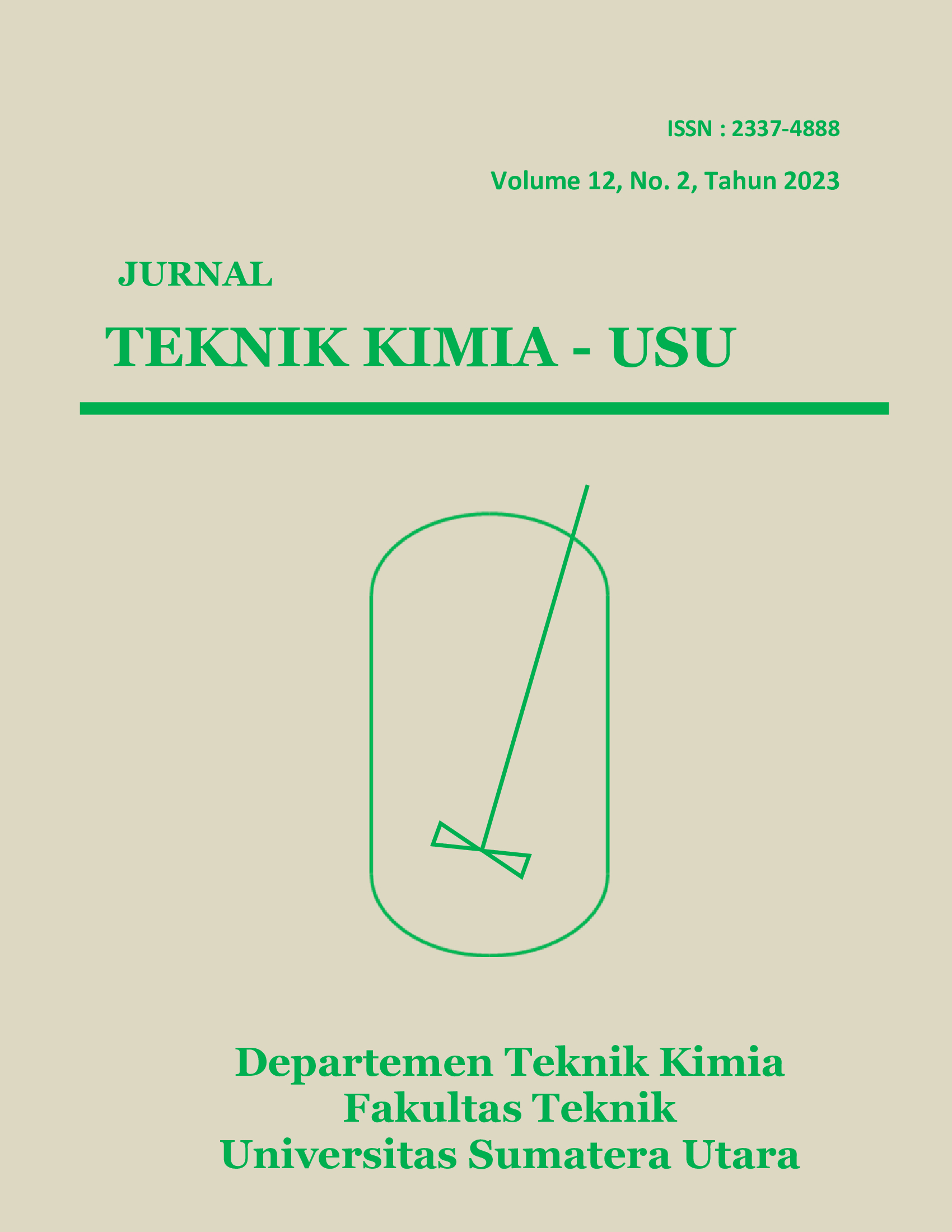Pengaruh Kondisi Operasi terhadap Karakteristik Pengeringan Jahe Merah (Zingiber officinale Var. Rubrum) Menggunakan Tray Dryer dengan Udara Panas dari Proses Pirolisis
DOI:
https://doi.org/10.32734/jtk.v12i2.11496Keywords:
red ginger, drying characteristic, drying rate, pyrolysis, tray dryerAbstract
Red ginger (Zingiber officinale Var. Rubrum) is a rhizome plant often used as a complementary spice, a mixed ingredient in the food and beverages, and herbal medicines. One of the post-harvest processing of red ginger is drying, which aims to reduce the water content of red ginger to a point where the growth of microorganisms and the activity of enzymes that can damage red ginger can be prevented. This study aims to evaluate the effect of tray height and drying air temperature on moisture content, drying rate, drying characteristics, and quality of red ginger dried using a tray dryer with hot air from a biomass pyrolysis process. The results showed that both tray height and drying temperature affected red ginger's water content and drying rate. The quality of red ginger that complies with SNI 1-3393-1994 was obtained at a tray height of 60 cm and a drying temperature of 70 °C, with distinctive aroma and taste characteristics, the water content of 8,9%; ash content of 5,5%; oil content of 4,93 mL/100 g; and no fungus on the red ginger.
Downloads
References
S. Hanief, Y. M. Pane, dan R. Hasibuan, “The effect of the molecular sieve position on the efficiency of solar-molecular sieve combination dryer,†in AIP Conference Proceedings, 2019, pp. 1–7.
R. Hasibuan and M. Bairuni, “Mathematical modeling of drying kinetics of ginger slices,†in AIP Conference Proceedings, 2018, pp. 1–7.
N. Lestari, Samsuar, E. Novitasari, dan K. Rahman, “Kinerja cabinet dryer pada pengeringan jahe merah dengan memanfaatkan panas terbuang kondensor pendingin udara,†J. Agritechno, vol. 13, no. 1, pp. 57–70, 2020.
R. Hasibuan, R. Manurung, R. Sundari, S. Alva, dan R. Anggraini, “The study of drying kinetics of Uncaria gambir roxb leaves applying convective desiccant drying,†Int. J. Adv. Sci. Technol., vol. 29, no. 3, pp. 739–749, 2020.
M. Yahya, H. Fahmi, dan R. Hasibuan, “Experimental performance analysis of a pilot-scale biomass-assisted recirculating mixed-flow dryer for drying paddy,†Int. J. Food Sci., vol. 2022, pp. 1–15, 2022.
B. Haryanto, R. Hasibuan, Alexander, M. Ashari, dan M. Ridha, “Herbal dryer: Drying of ginger (Zingiber officinale) using tray dryer,†in IOP Conference Series: Earth and Environmental Science, 2018, pp. 1–5.
R. Hasibuan dan H. Gusman, “Effect of operation condition on gelugur acid (Garcinia atroviridis) drying rate using tray dryer,†Talent. Conf. Ser. Sci. Technol., vol. 1, 2018, pp. 160–167.
B. Haryanto, R. Hasibuan, A. H. Lubis, Y. Wangi, H. Khosman, dan A. W. Sinaga, “Drying rate of turmeric herbal (Curcuma longa l.) using tray dryer,†in Journal of Physics: Conference Series, 2020, pp. 1–6.
A. Venkanna, P. S. Champawat, dan S. K. Jain, “Study on drying kinetics of coriander leaves using different drying techniques,†J. Pharmacogn. Phytochem., vol. 8, no. 3, pp. 3887–3895, 2019.
S. Sarkhel, D. Manvi, dan R. CT, “Comparison of drying characteristics and quality of tender mulberry leaves (Morus alba) using five different drying methods,†J. Med. Plants Stud., vol. 10, no. 1, pp. 30–35, 2022.
M. Yahya, A. Rachman, dan R. Hasibuan, “Performance analysis of solar-biomass hybrid heat pump batch-type horizontal fluidized bed dryer using multi-stage heat exchanger for paddy drying,†Energy, vol. 254, pp. 1–13, 2022.
M. Yahya, H. Fahmi, dan R. Hasibuan, “Experimental performance analysis of a pilot-scale biomass-assisted recirculating mixed-flow dryer for drying paddy,†Int. J. Food Sci., vol. 2022, pp. 1–15, 2022.
M. Yahya, “Design and performance evaluation of a solar assisted heat pump dryer integrated with biomass furnace for red chilli,†Intenational J. Photoenergy, vol. 2016, pp. 1–14, 2016.
Hamdani, T. A. Rizal, dan Z. Muhammad, “Fabrication and testing of hybrid solar-biomass dryer for drying fish,†Case Stud. Therm. Eng., vol. 12, pp. 489–496, 2018.
S. Sonthikun, P. Chairat, K. Fardsin, P. Kirirat, A. Kumar, dan P. Tekasakul, “Computational fluid dynamic analysis of innovative design of solar-biomass hybrid dryer: an experimental validation,†Renew. Energy, vol. 92, pp. 185–191, 2016.
T. Hariyadi, “Pengaruh suhu operasi terhadap penentuan karakteristik pengeringan busa sari buah tomat menggunakan tray dryer,†J. Rekayasa Proses, vol. 12, no. 2, p. 46, 2018.
Dewan Standardisasi Nasional, “SNI Jahe Kering.†1994.
R. Hasibuan, W. N. Sari, R. Manurung, dan V. Alexander, “Drying kinetic models of rice applying fluidized bed dryer,†Math. Model. Eng. Probl., vol. 10, no. 1, pp. 334–339, 2023.
P. Muthukumar, D. V. N. Lakshmi, P. Koch, M. Gupta, dan G. Srinivasan, “Effect of drying air temperature on the drying characteristics and quality aspects of black ginger,†J. Stored Prod. Res., vol. 97, pp. 1–9, 2022.
R. Hasibuan, Y. M. Pane, dan S. Hanief, “Effect of air velocity and thickness to drying rate and quality temulawak (Curcum xanthorrhiza roxb) using combination solar moleculer sieve dryer,†in International Conference of Science, Technology, Environmental, and Ramification Researchers, 2020, pp. 389–394.
Downloads
Published
Issue
Section
License
Copyright (c) 2023 Jurnal Teknik Kimia USU

This work is licensed under a Creative Commons Attribution-ShareAlike 4.0 International License.

















